MATH 516-101 Solutions to Homework Six u f
advertisement
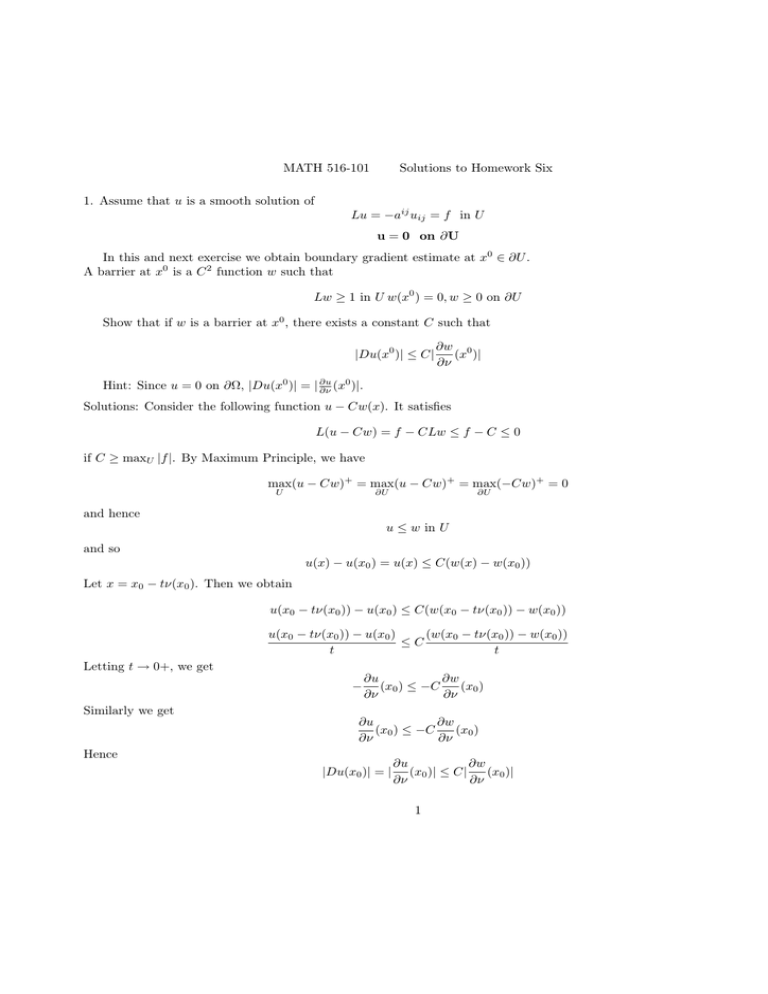
MATH 516-101
1. Assume that u is a smooth solution of
Solutions to Homework Six
Lu = −aij uij = f in U
u = 0 on ∂U
In this and next exercise we obtain boundary gradient estimate at x0 ∈ ∂U .
A barrier at x0 is a C 2 function w such that
Lw ≥ 1 in U w(x0 ) = 0, w ≥ 0 on ∂U
Show that if w is a barrier at x0 , there exists a constant C such that
|Du(x0 )| ≤ C|
∂w 0
(x )|
∂ν
0
Hint: Since u = 0 on ∂Ω, |Du(x0 )| = | ∂u
∂ν (x )|.
Solutions: Consider the following function u − Cw(x). It satisfies
L(u − Cw) = f − CLw ≤ f − C ≤ 0
if C ≥ maxU |f |. By Maximum Principle, we have
max(u − Cw)+ = max(u − Cw)+ = max(−Cw)+ = 0
U
∂U
∂U
and hence
u ≤ w in U
and so
u(x) − u(x0 ) = u(x) ≤ C(w(x) − w(x0 ))
Let x = x0 − tν(x0 ). Then we obtain
u(x0 − tν(x0 )) − u(x0 ) ≤ C(w(x0 − tν(x0 )) − w(x0 ))
(w(x0 − tν(x0 )) − w(x0 ))
u(x0 − tν(x0 )) − u(x0 )
≤C
t
t
Letting t → 0+, we get
−
Similarly we get
∂u
∂w
(x0 ) ≤ −C
(x0 )
∂ν
∂ν
∂w
∂u
(x0 ) ≤ −C
(x0 )
∂ν
∂ν
Hence
|Du(x0 )| = |
∂u
∂w
(x0 )| ≤ C|
(x0 )|
∂ν
∂ν
1
2. Continue from Problem 1. Suppose that U satisfies exterior ball property at x0 , i.e., there exists BR (y) ⊂ U c and
B̄R (y) ∩ Ū = {x0 }. Find a barrier w of the following type
w(x) = ψ(d(x)), where d(x) = |x − y| − R
Hint: Compute (letting y = 0)
ψi = ψ
0
00 xi xj
0 1
xi xj
xi
, ψij = ψ
(δij −
+ψ
)
2
|x|
|x|
|x|
|x|2
Find ψ such that
ψ(0) = 0
0
ψ ≥0
0
ψ
ψ +C
= −1
d+R
00
Solve the above ODE.
Solution: We compute as in the hint:
X
ψ
ψ X
(xi − yi )(xj − yj )
a ψij = (ψ −
aii
)
+
aij
|x − y| ij
|x − y|2
|x| i
0
0
00
ij
Assume that
00
0
ψ ≤ 0, ψ ≥ 0
. Then in order that
−aij ψij ≥ 1
we need
0
ψ
ψ +C
≤ −1
|x − y|
00
which is
0
ψ
ψ +C
≤ −1
d+R
00
where C can be chosen to be large.
Now solving the above ODE, we have
ψ=
1
[R2 − (d + R)2 ] − A[(d + R)−C+1 − R−C+1 ]
2(C + 1)
where A is a free parameter. We need
0
0 ≤ ψ (d) = −
1
(d + R) + A(C − 1)(d + R)−C
C +1
which is possible if A is large enough.
2
3. (Kelvin transform of Laplace equation) The Kelvin transform Ku is defined as Ku = |x|2−n u( |x|x 2 ). Show that if u
satisfies
∆u + f (u) = 0
then Ku satisfies
∆Ku +
1
f (|x|n−2 Ku) = 0
|x|n+2
Solution: Direct computations. One way is to use the following formula
∆u = urr +
∆ n−1 u
n−1
ur + S 2
r
r
where
1
Ku(r, θ) = r2−n u( , θ)
r
4. Use direct method to prove the existence of a smooth solution to
∆u + λu − u3 = 0 in U, u = 0 on ∂U
where
λ > λ1
Show all details. Prove the uniqueness of the solution.
Hint: 1. Show that the minimum of the energy
Z
Z
Z
1
λ
1
J[u] =
|∇u|2 −
u2 +
u4
2 U
2 U
4 U
is attained in the following Banach space
Use Fatou’s Lemma:
X = H01 (U ) ∩ L4 (U )
Z
Z
lim G(un ) ≤ lim
U
n
n
G(u)
U
where G(u) = |∇u|2 or G(u) = u4 .
2. Show that the energy is negative by taking a test function tφ where φ is the first eigenfunction.
3. Uniqueness follows from the class work, since f (u)/u = λ − u2 is decreasing in u.
Solution: We first prove the existence. Let
J[u] =
where
1
2
Z
|∇u|2 −
U
λ
2
Z
u2 +
U
1
4
u ∈ X = H01 (U ) ∩ L4 (U )
Note that X is a Banach space under the following norm:
kuk = kukH01 (U ) + kukL4 (U )
3
Z
u4
U
Step 1: we prove the existence of a minimizer
c = inf J[u]
u∈X
In fact, by any test function, it is easy to see that c is bounded. On the other hand, since
u4 − 2λu2 ≥ −C
we obtain that
|c| ≤ C < +∞
Let {un } be a sequence of minimizing sequence. Then we have
Z
Z
Z
Z
Z
1
1
λ
1
1
|∇un |2 +
u4 − C ≤
|∇u|2 −
u2 +
u4 ≤ C
2 U
8 U
2 U
2 U
4 U
which implies that
Z
Z
2
|∇un | ≤ C,
U
U
u4n ≤ C
Thus un contains a subsequence unk such that unk → u0 in L2 , by Sobolev embedding.
But by Fatou’s Lemma
Z
Z
2
|∇u0 | ≤ lim
|∇unk |2
U
k→+∞
Z
U
u40 ≤ lim
k→+∞
Z
U
U
u4nk
Hence
u0 ∈ X
J[u0 ] ≤ lim J[unk ]
k→+∞
By the definition, u0 is a minimizer in X.
Step 2: Let φ ∈ C0∞ (U ). Then
J[u0 + tφ] ≤ J[u0 ], ∀t
Thus
Z
0
0 = J [u0 ](φ) =
U
Hence u0 is a weak solution to
∇u0 ∇φ − λu0 φ + u30 φ
∆u0 + λu0 − u30 = 0
Step 3: u0 > 0
First of all, let ²φ1 be a test function, where φ1 is the first positive eigenfunction. Then we have
Z
²2
c ≤ J[²φ1 ] ( |∇φ1 |2 − λφ21 ) + O(²4 ) < 0
2 U
since λ > λ1 . Thus u0 6≡ 0.
4
Next, replacing u0 by |u0 |, we can assume that u0 ≥ 0. Since u0 satisfies
−∆u0 + λu0 = −u40 ≤ 0
we infer that u0 is a weak sub-solution, hence by Moser’s iteration u0 ∈ L∞ . By W 2,p theory, u ∈ C 1,α . By Schauder,
u0 ∈ C 2,α .
Finally by Maximum Principle, u0 > 0.
Step 4: We show uniqueness.
Writing f (u) = λu − u3 , then by Picone’s identity we get
Z
Z
Z
f (u1 ) f (u2 )
u2
u1
(
u21 |∇ |2 −
−
)(u1 − u2 ) −
u22 |∇ |2 = 0
u
u
u
u2
1
2
1
U
∂U
∂U
Now note that f (u)/u = λu − u2 is decreasing. All the three terms in the above equality are negative, and hence
uniqueness follows.
5. Use Mountain-Pass Lemma to prove the existence of a positive solution to
1
²2 ∆u + u(u − )(1 − u) = 0 in U
3
0 < u < 1 in U
u = 0 on ∂U
where ² > 0 is sufficiently small.
Hint: 1. modify the nonlinearity to be zero for u > 1 and u < 0. 2. Show that the Mountain Pass Lemma is satisfied.
To show that J(e) < 0. Choose a function e = 1 in most of the part of U except a thin part near the boundary. Then
for ² sufficiently small, J(e) < 0. 3. Use Maximum Principle to show that 0 ≤ u ≤ 1. In fact if the minimum is negative
at some place p then ∆u = 0 in a neighborhood of p. By Maximum Principle for harmonic function this is not possible.
4. Use Strong Maximum Principle to show that 0 < u < 1.
Solution: Let f (u) = u(u − 1/3)(1 − u). We first modify
f (u), 0 ≤ u ≤ 1
0, u ≤ 0
f¯ =
0, u ≥ 1
and F̄ (u) =
Ru
0
f¯(s)ds. Certainly
F̄ (1) > 0
0
f¯ (0) ≤ 0
Let
²2
J[u] =
2
Z
Z
2
|∇u| −
U
F̄ (U )
U
We now check that J and F̄ satisfies the Mountain-Pass Lemma
(1) J[0] = 0
5
0
(2) J[u] ≥ ckuk2 for kuk = r << 1. In fact, for u small, F̄ (u) ∼ f (0)u2 /2 + O(u3 ) and hence
Z
²2
|∇u|2
J[u] ≥
2 U
(3) There exists e ∈ H01 such that J[e] < 0. In fact we choose e = 1 when d(x, ∂U ) > δ > 0 and 0 ≤ e ≤ 1 for
d(x, U ) ≤ δ. Then we compute
Z
Z
²2
2
J[e] =
|∇e| −
F (e)
2 U
U
Z
≤ C²2 −
F (1) < 0
d(x,U )≥δ
if ² is sufficiently small.
(4) F̄ satisfies |F̄ (u)| ≤ C(1 + |u|p ) for p <
This is trivial since f¯ is bounded and hence |F̄ (u)| ≤ C(1 + |u|).
2 R
0
(5) F̄ satisfies the (PS) condition: First of all, J[un ] → c and J [un ] → 0. Then ²2 U |∇un |2 ≤ J[un ] + C ≤ C and
hence un is bounded in H01 . Since f¯ is bounded, we have the convergence of f (un )un and F (un ).
By Mountain-Pass-Lemma, we obtain the existence of a critical point of J[u] and hence a weak solution to
n+2
n−2 .
²2 ∆u0 + f¯(u0 ) = 0
We then claim that 0 ≤ u0 ≤ 1. In fact, if minU u0 = u0 (p) < 0, then f¯(u0 (x)) = 0 for u0 (x) ≤ 0. By Maximum
Principle, it is impossible. This implies that u0 ≥ 0. Similarly we can prove that max u0 ≤ 1. Finally by Strong
Maximum Principle, 0 < u0 < 1.
6
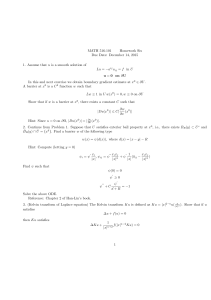
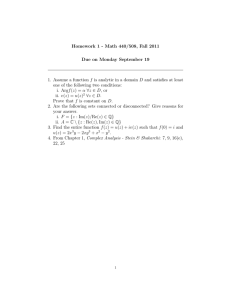
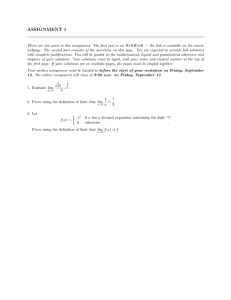
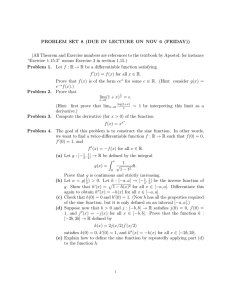
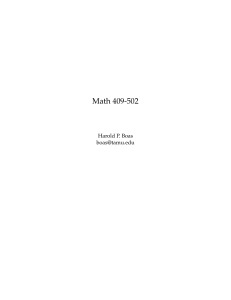
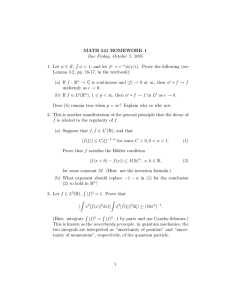
![MA1124 Assignment5 [due Monday 16 February, 2015]](http://s2.studylib.net/store/data/010730348_1-77b9a672d3722b3831a1e52597d5a881-300x300.png)


